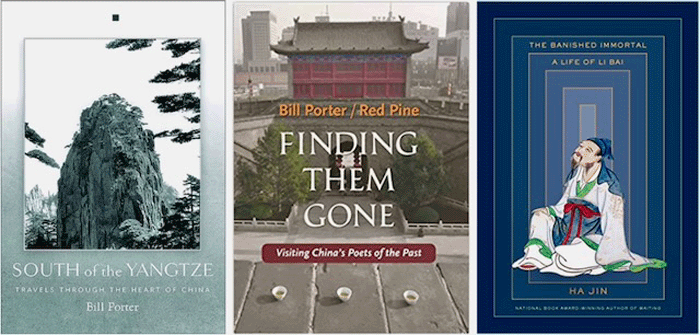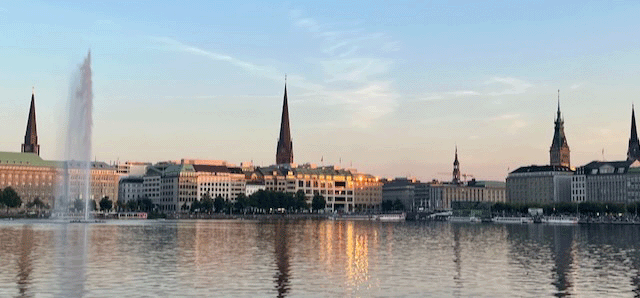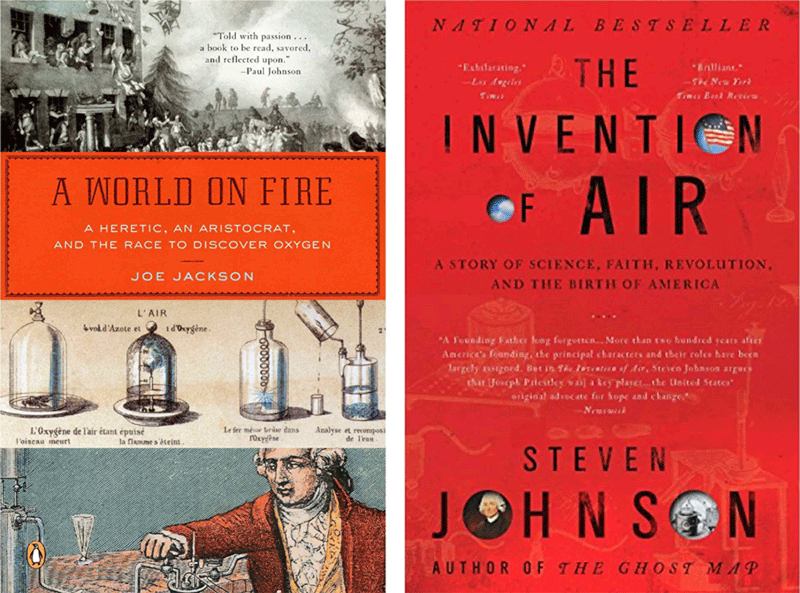Bletchley Park
February 5, 2024
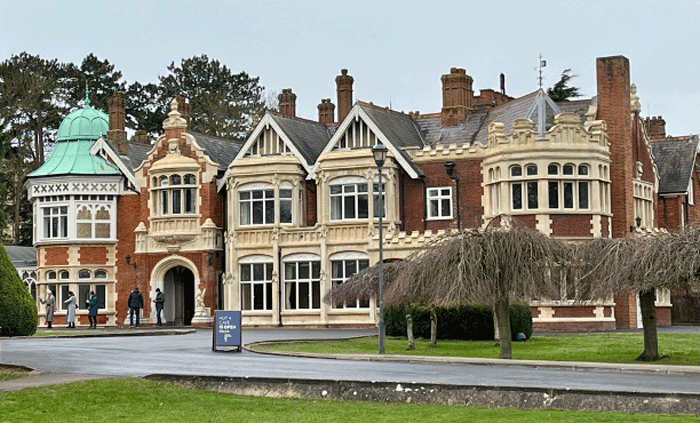
With all of the recent attention devoted to AI, I decided to visit a notable landmark on this London visit: Bletchley Park, where Alan Turing and his colleagues were able to break the German ‘Enigma’ codes in WWII. The estate is located about an hour’s train-ride north of London, and has two major sites: 1) the complex where, by the end of the war, nearly 9,000 people were working on cryptography and intelligence gathering; and 2) a separate National Museum of Computing, which claims to have “the world’s largest collection of working historic computers.”
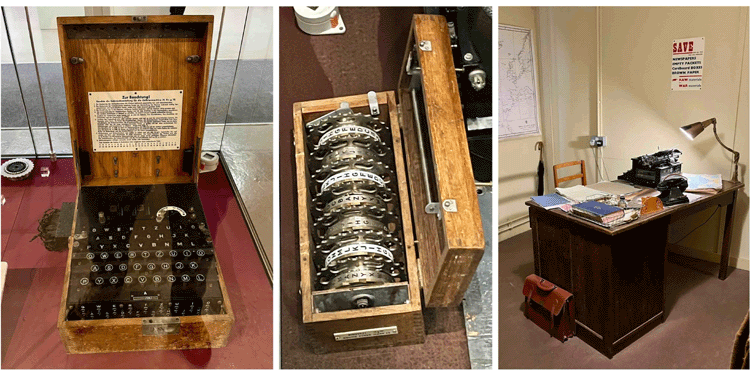
Both were quite fascinating. Anyone familiar with Alan Turing’s tragic story – a mathematical and technological genius driven to suicide because of his homosexual tendencies, despite having played a key role in enabling the Allies’ victory in WWII – will marvel at his actual accomplishments. The Enigma machines had six rotors, and scrambled messages accordingly. Turing laid out an approach in a “bombe” computer that could be used to determine the rotor settings – and thus decipher messages. Later in the war, strategic messages from the German headquarters were sent with an additional six rotors – and the British developed an even more powerful dedicated-purpose computer... the Colossus!
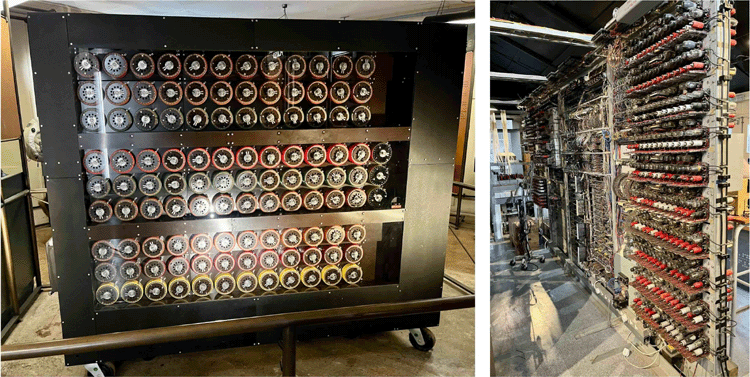
What is especially impressive about the Bletchley Park exhibits is that they have re-developed working versions of these machines…. and are thus able to show the exact tasks that people there were performing. It’s a fascinating example of human ingenuity – and dedication to a crucial cause.
Royal Institution
February 5, 2024
Last year’s visit to the U.K. focused on rock & roll – and I decided to get a bit more serious on this year’s return, on my way home from China. I arranged a personal scientific history tour with Laurence Scales, a knowledgeable guide who took me through the Royal Institution of Great Britain in Mayfair, and well as nearby historical sites in Soho.
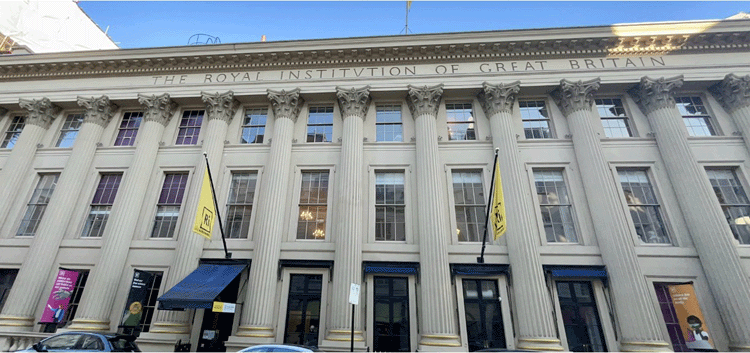
The Royal Institution (RI) was founded in 1799, with a mission a bit more practical than the better-known Royal Society – although its personnel were equally distinguished. Early leaders included the chemist Humphrey Davy (inventor of the Davy lamp); the electrochemist Michael Faraday; and – especially relevant today – the Irish physicist John Tyndall, often called the father of climate science, because of his determination of the absorptive capacities of individual gases in the atmosphere. [Tyndall met an unfortunate end when he was accidently (?) poisoned by his wife.]
By lucky happenstance, we were able to get into the laboratory of the Faraday Museum – still locked with the original key that Faraday used. Laurence also told me about another distinguished RI scientist that I didn’t originally recognize: Thomas Young. I did vaguely recall Young’s Modulus from my days as an engineering lab assistant in a materials science course back in the early 1970s…. but his description of this polymath led me to a fascinating book by Andrew Robinson, entitled The Last Man Who Knew Everything:Thomas Young.
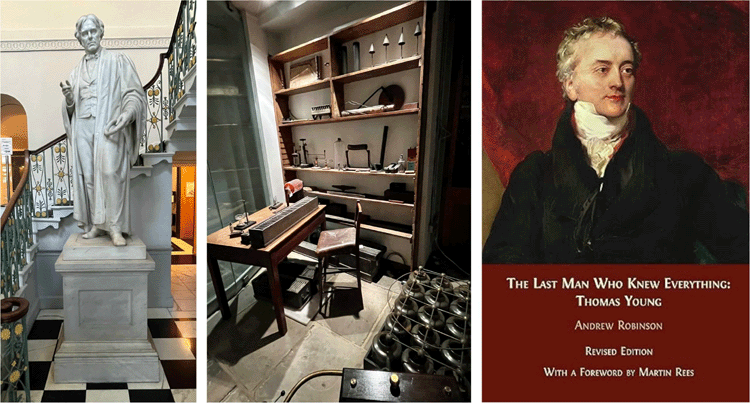
In addition to material science, Young had ground-breaking scientific ideas in optics, medical physiology, language theory, and – perhaps most surprisingly – Egyptian hieroglyphics. He was, however, a rather poor lecturer at the Royal Institution: since he knew everything, he apparently assumed that others did as well.
Battersea Power Station
February 5, 2024
When I was a young boy, I often traveled to London by train…. and knew I was getting close to Victoria Station when the train passed the iconic Battersea Power Station. Peter Watts begins his book about the power plant, Up in Smoke, describing exactly that same experience -- although the view is no longer available. Instead, it has been blocked by upscale condominiums, part of the re-development that occurred years after the power plant was closed.
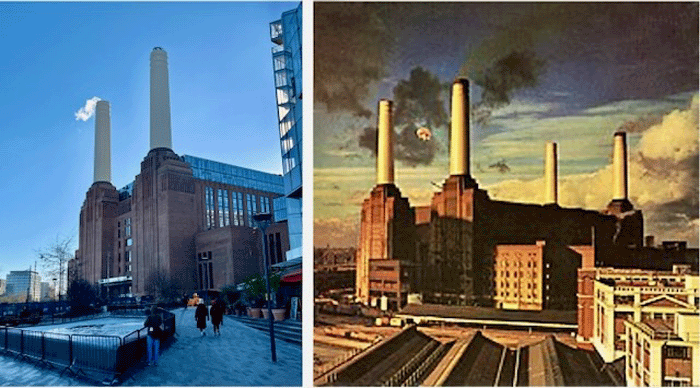
Cover design: Hipgnosis
Watts tells the story of that re-development, but truthfully I was much more interested in another part of its history. I discuss the power plant in my energy technology course, because it was the site of the very first flue gas desulfurization (FGD) system, utilizing Thames River water to remove acidic sulfur dioxide from the exhaust gas of its coal-fired units. This was not a comprehensive environmental solution, because the resulting liquid effluent was dumped back into the river – but it was a start.
Watts’ book was very informative, however, because I did not realize how important the FGD unit was in getting approval for building such a major coal-burning facility right in the middle of the city. That was close to the electrical load demand, but even then (early 1930s) citizens were concerned about the pollution. Similarly, as Watts notes, it had an effect on the iconic design:
For the [FGD] process to function, chimneys needed to be sited at either end of the flues, which ran the entire length of the building: this would eventually give Battersea Power Station its distinctive appearance.
Today the power plant houses an upscale shopping center in its turbine halls, and one can take an elevator up to the top of one of those iconic stacks on Lift 109. The power plant has played a key cultural role in numerous movies, and received special attention in 1977 when it appeared on the cover of Pink Floyd’s Animals album. That featured a pink pig flying between its stacks – although the pig unfortunately became untethered, disrupting air traffic and ending up in Kent.
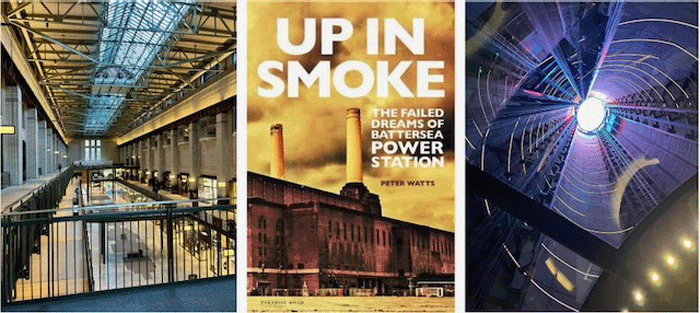
Li Bai
February 5, 2024
I’ve always thought that the person who best captured the spirit of traveling in China is Bill Porter (Chinese name ‘Red Pine’), who does translations of Chinese poems. His notable books include South of the Yangtze and Finding Them Gone, the latter getting its title from the frequent lament of Chinese poets who arrive at a long-sought destination to meet a colleague or friend, only to be disappointed.
One frequent subject of Porter’s books is Li Bai (or Li Pai or Li Po in Western translations), a famous poet from the Tang Dynasty whose poems are memorized by all Chinese school children. One particularly interesting Western tribute is Ezra Pound’s beautiful & touching The River-Merchant’s Wife: A Letter… a poem ‘after Li Po.’ Pound revolutionized modern poetry, and published a well-known collection Cathay dedicated to such translations….. even though Pound did not speak any Chinese! More recently, Li Bai was the subject of a 2019 biography from the National-Book-Award winning author Ha Jin.
There are two things likely to be found in any Li Bai poem: his love of drinking wine & spirits, and the moon. Not surprising, then, the legend of his passing links these topics: supposedly, Li was out in a boat on the Yangtze River, and saw a reflection of the moon on the water – and in his inebriated effort to capture it, fell overboard and drowned. The site of that drowning is memorialized at Caishiji Park in Ma’anshan, a city about 35 kilometers from Nanjing, and it’s long been on my “must-see” list – yet another China site visit disrupted by covid!
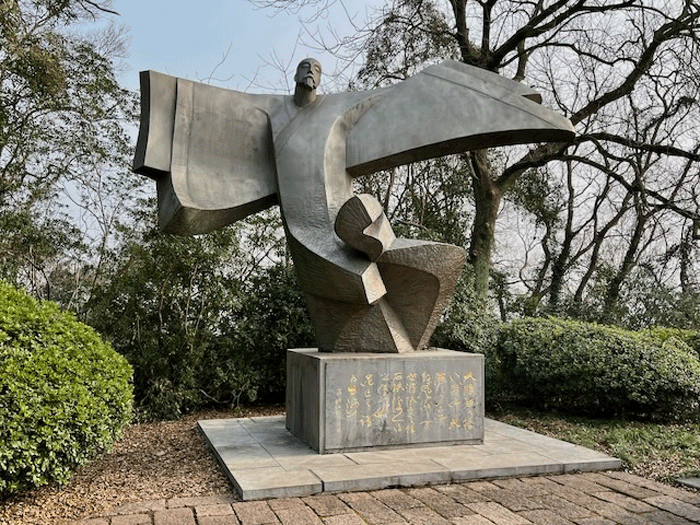
Luckily, an HNC law student in one of my ERE classes, Ms. Chen Junjie, was kind enough to take me there this semester, acting as a guide and helping me locate Qian Shaowu's well-known statue of Li Bai, showing him in flight as an immortal. We also headed to another site a further 20 kilometers away, the tomb where at least some of his remains are reportedly buried. That location had an aroma more like a distillery, however, as those paying homage – including Bill Porter and his colleagues – typically douse the tomb with liquid offerings.
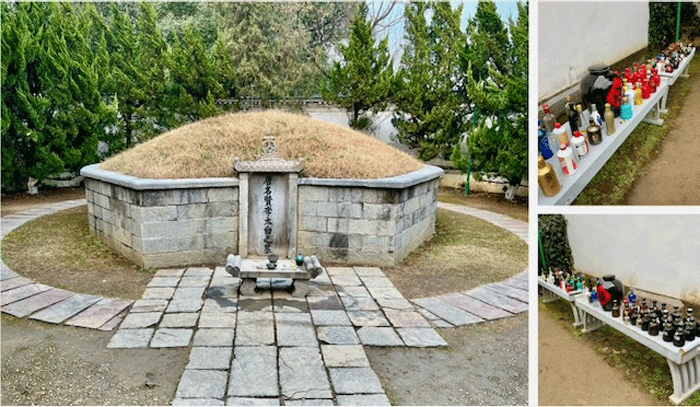
Hamburg
September 30, 2023
I came back to China via Europe, and stopped in to see my good friends Janosch & Jana – both Ph.D. environmental economists whom I’ve known for many years, and who have welcomed me on various vacation stays in Tuscany, Southern France, etc. They live in Buchholz, a town just south of Hamburg – and this was my chance to visit a city that I’m afraid I knew very little about…. other than that the Beatles had spent time and played there before becoming world famous.
Hamburg sits about a hundred kilometers from the North Sea on the Elbe River, and I had always thought of it as an in-land city – never realizing the importance of its port (in both historical and present-day terms). I had also never realized how lively and beautiful it is – with parks and old-time port buildings, modern architecture like the Elbphilharmonie, and a vibrant nightlife in the red-light Reeperbahn district (where the Beatles played in joints typical of a port city).
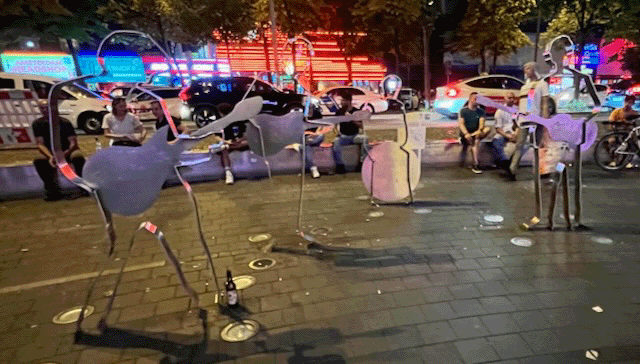
Following up on my recent London & Liverpool visit, we headed to Beatles-Platz one warm evening, to see the sights. It’s a bit difficult to capture and appreciate the ‘see-through’ Beatles statues in the photo above – as well as the fact that the black circular setting is shaped like a giant vinyl record. But the photo does give some indication that the Reeperbahn remains a lively place!
Other site visits included the city-center Binnenalster lake (with its notable fountain, seen in the initial photo above); the City Hall ‘Rathaus’; the former city wall area, now transformed into a scenic city park; the UN World Heritage Site historic port area; and the spire remains of the old St. Nicholas church – now a memorial of the city’s bombing in World War II.
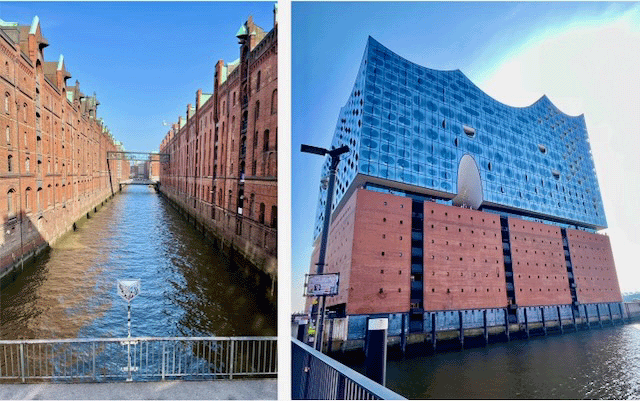
I was visiting Hamburg on my way to China, getting ready to teach my environmental course (over-subscribed, with 39 students signed up!) – and took along a very recent book, Dan Egan’s The Devil’s Element, about the worrisome pollutant phosphorus. Phosphorus is one of two pollutants (the other being nitrogen) that cause massive algal blooms in lakes and offshore areas around the world, and the element has become a major pollution concern. What I did not realize, however, was that Hamburg would play a major role in the book!
An early chapter in this fascinating work describes the discovery of phosphorus by the alchemist Hennig Brandt in the city in 1669. Brandt was a failed glass-maker who became a self-proclaimed Doctor (of both medicine & philosophy) – despite having no formal education. He isolated phosphorus with a recipe that involved boiling vats of urine, but was never able to take the ultimate desired step – to turn it into gold. It is extremely flammable, however, and can spontaneously ignite if exposed to air -- burning both equipment and any nearby flesh, making its production a very risky endeavor!
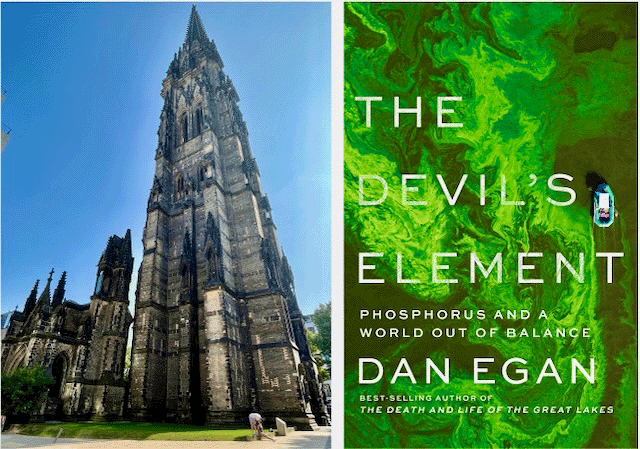
Such characteristics led to the story of that bombed-out church memorial. The Allies used phosphorus in their bombs, which were specifically designed to maximize the incendiary effects of such weapons. The death toll from Operation Gomorrah in Hamburg is not precise, since in some cases no bodies remained; it burned so hot that physicians weighed ashes to estimate the fatality rate (estimated at about 38,000 persons).
Egan’s book ends with a company building a state-of-the-art phosphorus recovery plant in the city, on the west bank of the Elbe River, to tackle this very necessary mineral – but also current environmental scourge. The devil’s element indeed!
Joseph Priestley House
August 25, 2023
I begin my energy course at HNC every year with a discussion about combustion, since it makes up about 82% of primary energy (still!). We burn coal, oil, natural gas, trash, wood, agricultural waste, and much, much more. Combustion is a chemical reaction (rapid oxidation), and that in turn leads us to review the work of Joseph Priestley, who discovered the gas oxygen, and Antoine Lavoisier, who gave it the name “oxygen” and recognized its role in the combustion process.
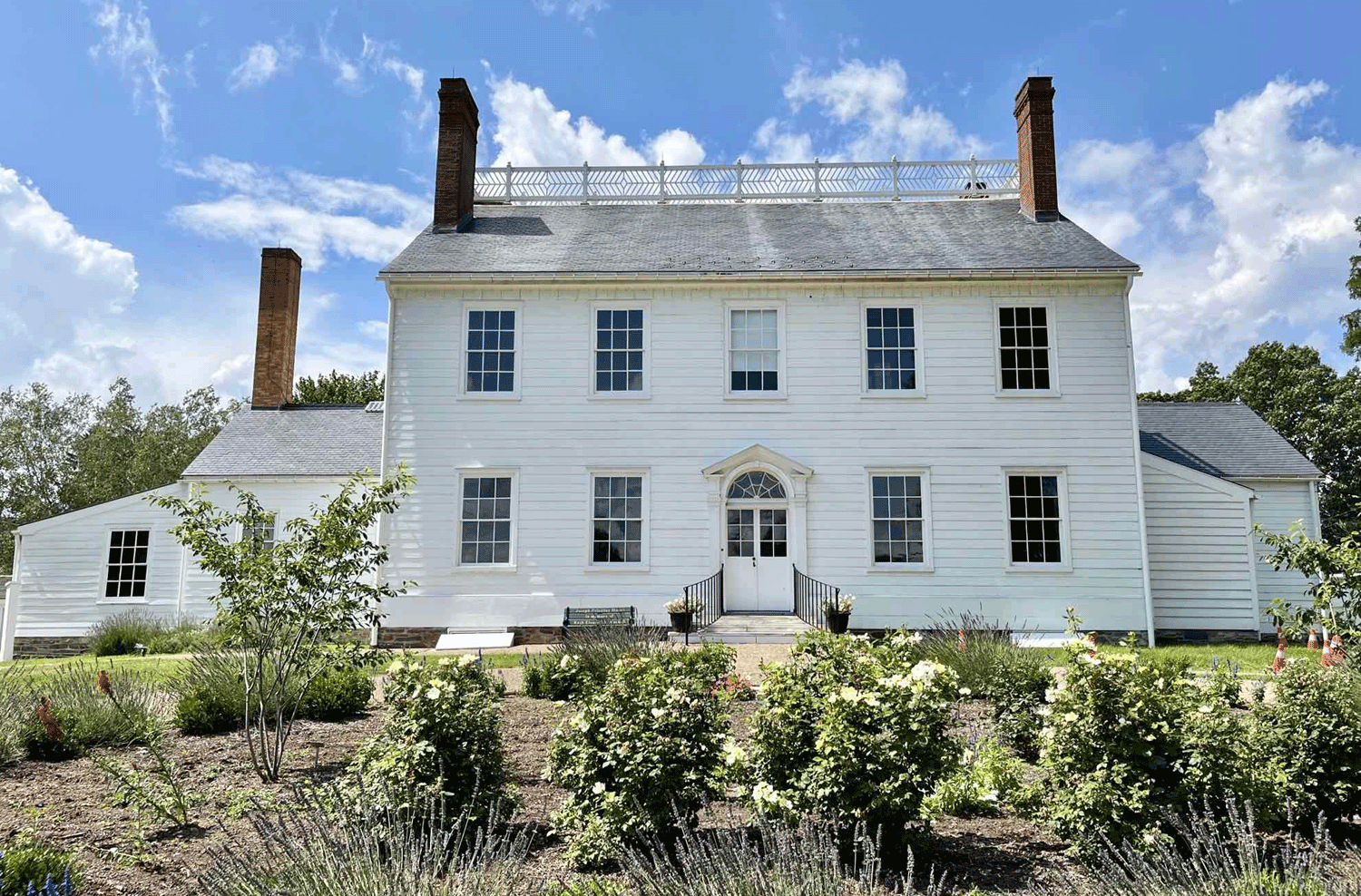
Priestley was a Unitarian preacher in the U.K. who was nonetheless a world-class chemist. His “non-conformist” religious and liberal views got him into trouble, and his house was burned down by a mob. He fled to Philadelphia in the U.S. in 1794, and ultimately settled in Northumberland, Pennsylvania, a town on the Susquehanna River – at the time a five-day trip from the city.
It was only a three-hour drive for me, however – and so I made the trip to Joseph Priestley’s House to see the museum and laboratory during an August sojourn to a family reunion in the western part of the state.
Priestley had met Lavoisier in Paris in 1774, and described his experiments – which Lavoisier subsequently repeated. Prior to that time, chemists had believed in “phlogiston”, a substance present in combustible materials and released into the air during burning. Lavoisier’s insights overturned that view and revolutionized chemistry, although Priestley remained a phlogiston believer until the end of his life. [He had labeled oxygen “dephlogisticated air,” so we’re lucky that Lavoisier’s chemical ideas ultimately prevailed!] Lavoisier revolutionized chemistry, but he ultimately lost his head to the guillotine during the French Revolution.
Their stories are well-told in a couple of books that I recommend to my students, shown below. Despite his combustion reticence, Priestley was a brilliant chemist, and he published more than thirty scientific papers during his stay in Northumberland – including discovery of the gas carbon monoxide (with another unfortunate label: “heavy inflammable air”). The American Chemical Society has noted that his library (with some 1600 volumes) and chemical laboratory “were probably the best in the country at that time,” and his domicile has now been designated a National Historic Chemical Landmark.
Garibaldi in New York
July 14, 2023
Every day on my morning walk in Bologna, I passed by a statue on the Via dell’Indipendenza of Giuseppe Garibaldi on horseback (pictured in a previous posting). It’s impossible to summarize his importance in Italy – his heroism in battle, and the personal charisma that played such a key role in the Italian Risorgimento. His ‘red shirt’ conquest of Sicily was a major theme in The Leopard, mentioned in last year’s posting, and seemingly every city in the country has its Piazza or Via Garibaldi, along with Cavour, Mazzini and Vittorio Emanuele equivalents.
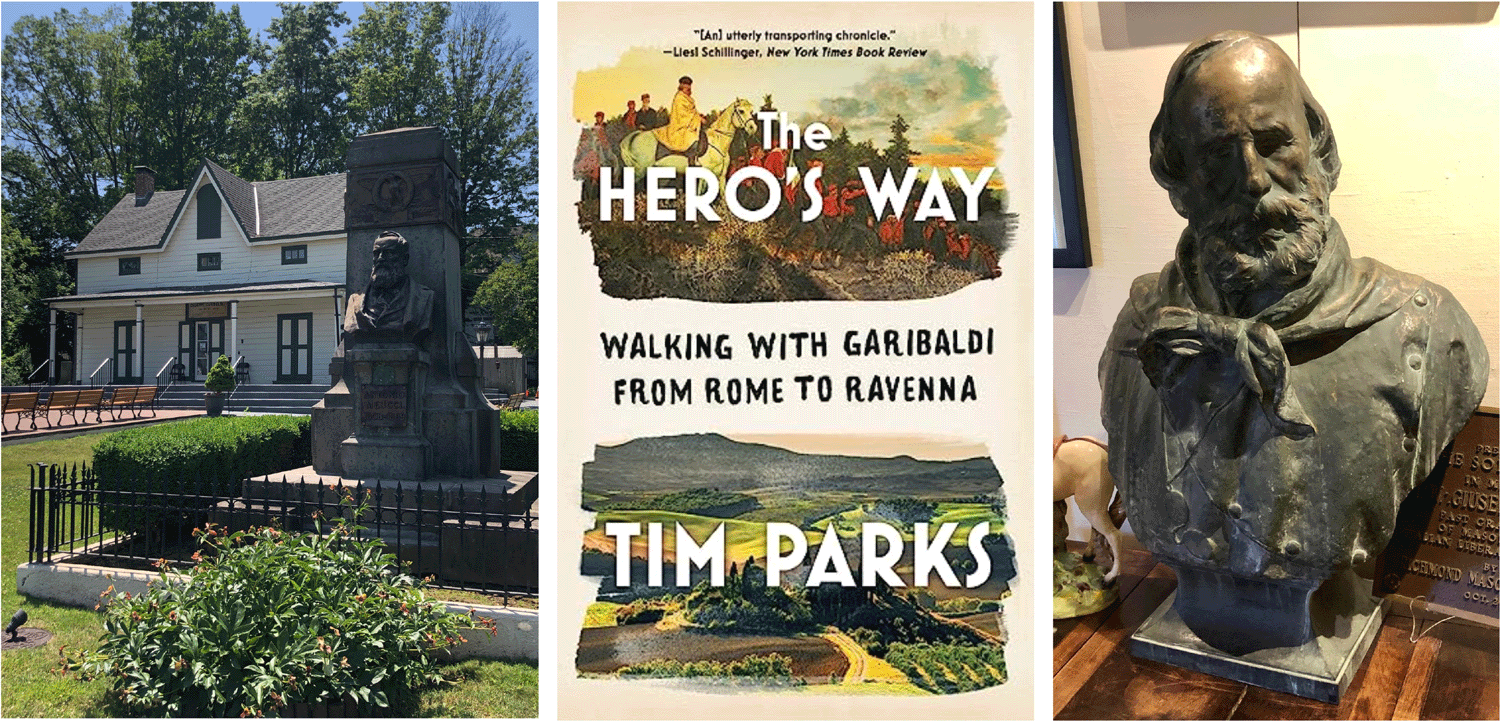
My Italian stay led me to pick up a copy of Tim Parks’ fascinating The Hero’s Way, which is subtitled Walking with Garibaldi from Rome to Ravenna. Parks re-created (on foot) Garibaldi’s 1849 four-hundred-mile trek across the Apennine Mountains of central Italy, with a pregnant Brazilian wife and 4,000 soldiers, being chased by Austrian, Spanish, French and Neapolitan armies. By the time he reached the Adriatic coast there were only 250 soldiers left, and Garibaldi’s wife, Anita, soon passed away as well.
Garibaldi originally came from a maritime family, and traveled the world. His exploits in South America (especially Uruguay and Brazil) are well-known, but he also traveled to China (Guangzhou and Xiamen), and spent several years on Staten Island in New York City.
There is a museum at the latter site, the Garibaldi Meucci Museum, and I’ve been wanting to visit it for some time. Luckily, a trip to New York City to pick up my Chinese visa gave me a good excuse. I spent much more than the allotted 45 minutes with the tour guide – and there was even a tie-in with my recent Civil War tours. Apparently President Lincoln was so dissatisfied with Union generals that he offered a Major General’s commission to Garibaldi to fight for the Union Army. Garibaldi refused (given his activities in Italy), but a New York Infantry Regiment of volunteers known as the “Garibaldi Guard” was recruited and did serve the Union cause.
Southern Tour redux
July 14, 2023
Southern trips to visit friends during the past two summers have offered an opportunity to visit U.S. Civil War sites, and this year I did the same once again -- although this year’s historical quest was a bit more expansive!
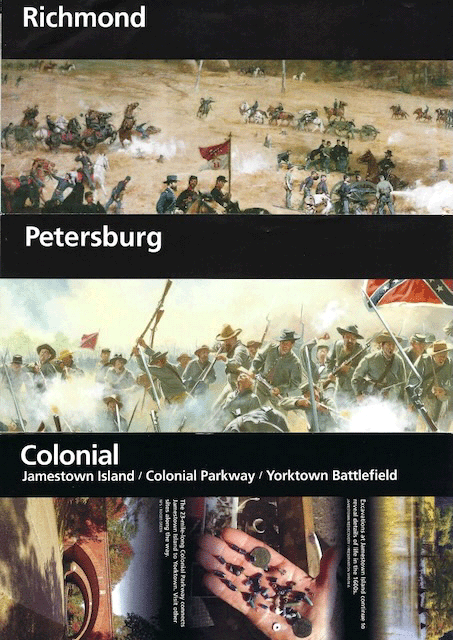
I headed to Richmond, the former Capital of the Confederacy – and, not surprisingly, the focal point of conflict throughout the war. Gaines’ Mill was the site of 1862’s Seven Days’ Battles, and nearby Cold Harbor was a part of 1864’s Overland Campaign (which was seen as the battle which shifted strategy from one of maneuver to one of siege). The siege in Petersburg, a city about 20 miles south of Richmond, lasted a full nine and a half months – and is best known for ‘The Crater,’ when Union troops blew up four tons of explosives under a Confederate battery. The resulting battle was costly for both sides, with 5,500 casualties.
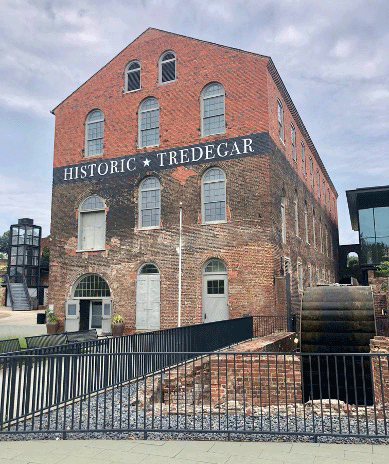
In Richmond itself, the Tredegar Iron Works was the center for iron manufacturing in the southern states, and provided artillery, ammunition, cannons and armor plating for the Confederate war effort. Today it houses the American Civil War Museum, and I was very, very surprised to find inside a painting of Maximilian and the Mexican firing squad, noted in the Trieste posting immediately below. The exhibit focused on the South’s ambitions, and noted that the Confederacy hoped to leverage the Mexican situation into diplomatic recognition of their nation by France -- but that never happened.
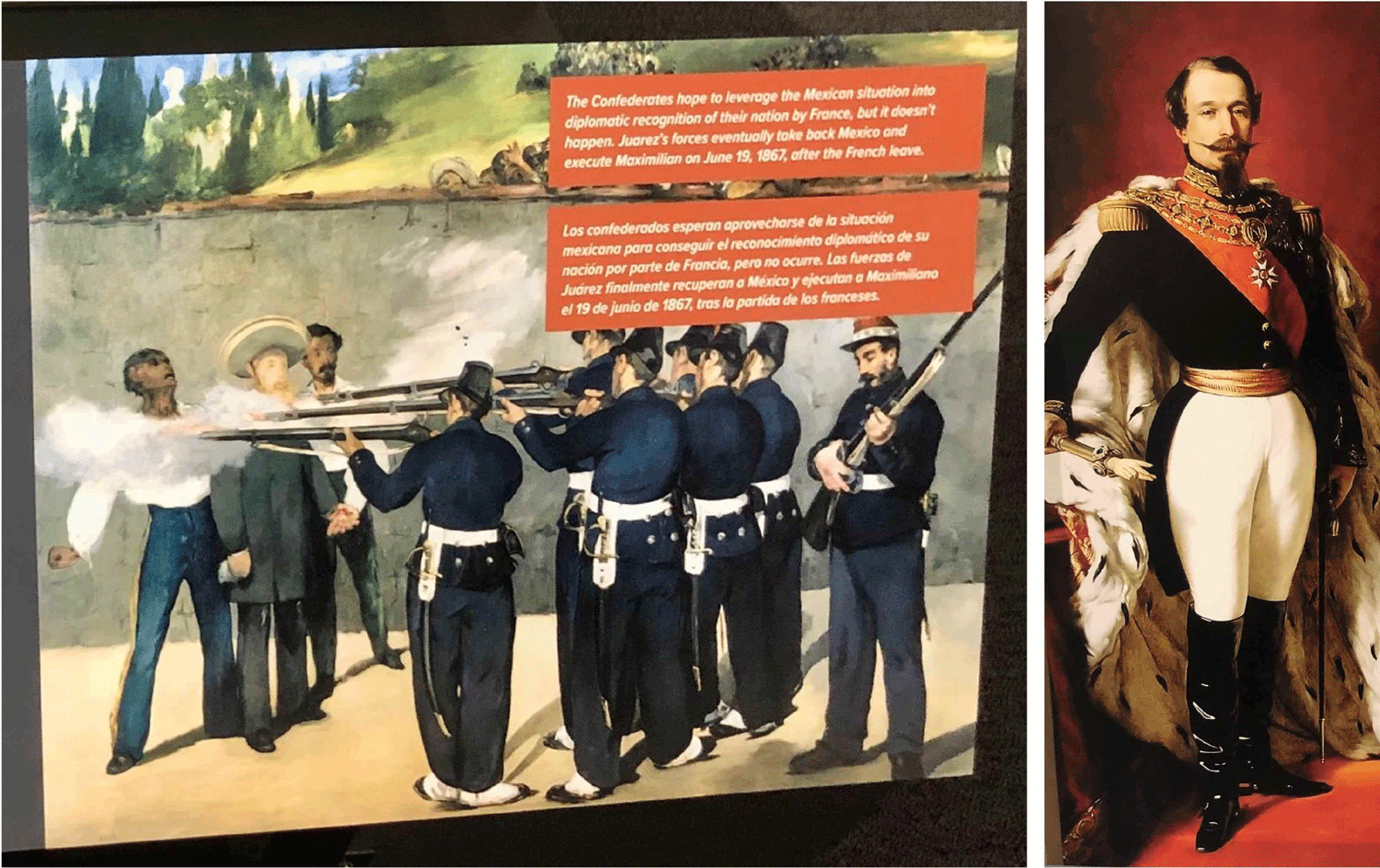
The next stops on this Southern tour both preceded the Civil War. Jamestown is where the first English colony was established in North America, and the Yorktown Campaign led to a battlefield in Virginia where George Washington (and the French) defeated the British army, and won independence for the American colonies. They are connected by a beautiful 23-mile Colonial Parkway.
While Jamestown Island provides the site of the original fort and nearby Jamestown Settlement contains replicas of the sailing ships, most visitors seemed more interested in the story of Pocahontas. The daughter of the Indian tribal chief, she was captured during a skirmish between the settlers and natives; ended up marrying a settler; bore a son; traveled to England, where she was a social curiosity; set out to return to Virginia – but died and was buried at Gravesend, on the Thames…. all by the age of 21. Perhaps not surprisingly, she also ended up as the subject of a 1995 Disney animated movie.
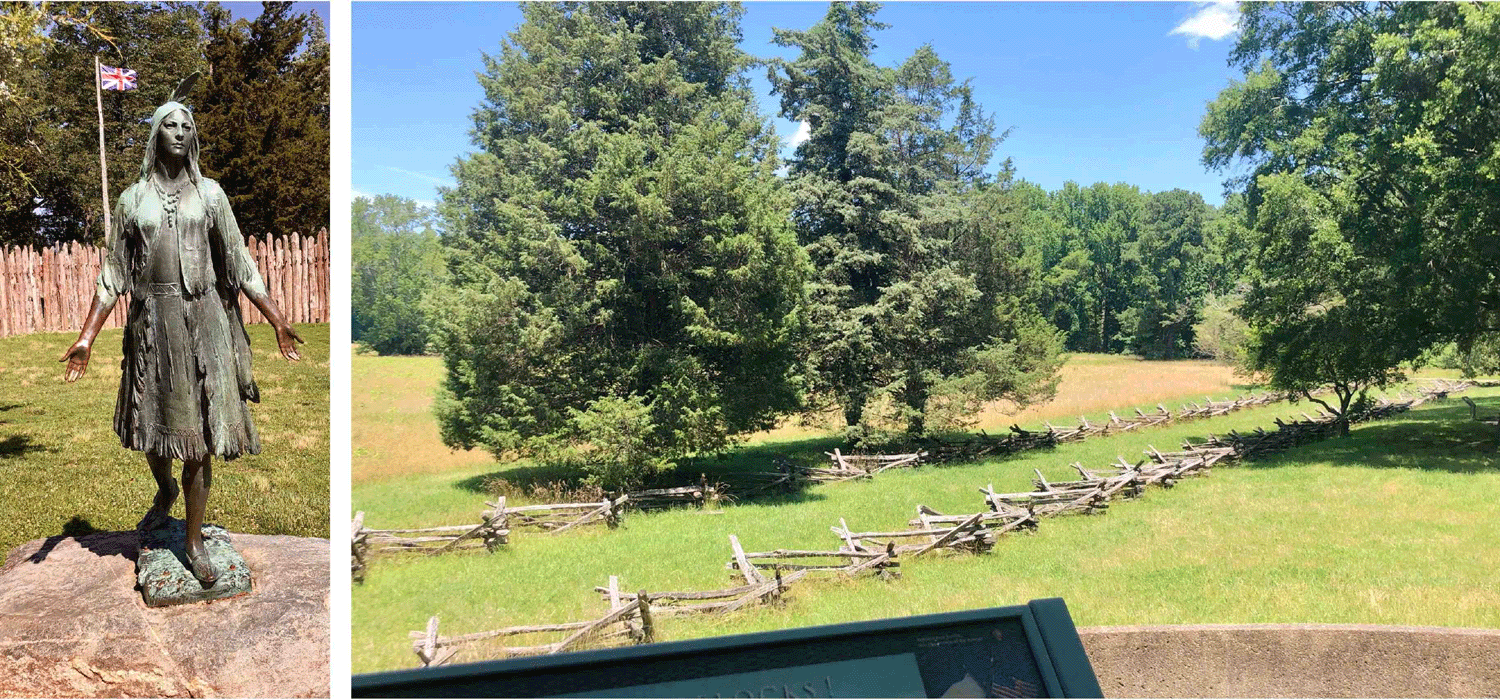
Yorktown has a “Surrender Field” where the British laid down their arms – although Lord Charles Cornwallis claimed to be ill that day, October 19, 1781, so he didn’t have to face Washington or the American troops.
Trieste
July 14, 2023
Ever since I read Jan Morris’s book Trieste and the Meaning of Nowhere several years ago, the city has been on my ‘bucket list.’ The trip home from Bologna gave me a chance to make that a reality – and a re-reading of the book made the visit especially interesting!
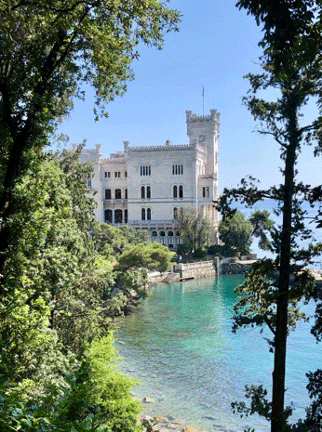
I was helped by the fact that I had arranged for an especially fascinating guide: Lubos Dzuro-Canulli has lived in the city for decades, and made sure that I visited the appropriate cafes, museums and churches. He also went out of his way to arrange a visit to Miramare, a site I had negligently failed to include in my original itinerary – but was not to be missed! Maximilian, younger brother of the Austrian Emperor Franz Joseph I, built it in the 1850s – but was soon on his way to North America (with Napoleon III’s assistance) to become Emperor of Mexico. That was ill-advised, because shortly thereafter he was put up against a wall in Mexico and shot. His wife Carlotta returned to Europe, but spent the next sixty years in an unfortunate mental state – and “Carlotta’s curse” still haunts the castle.
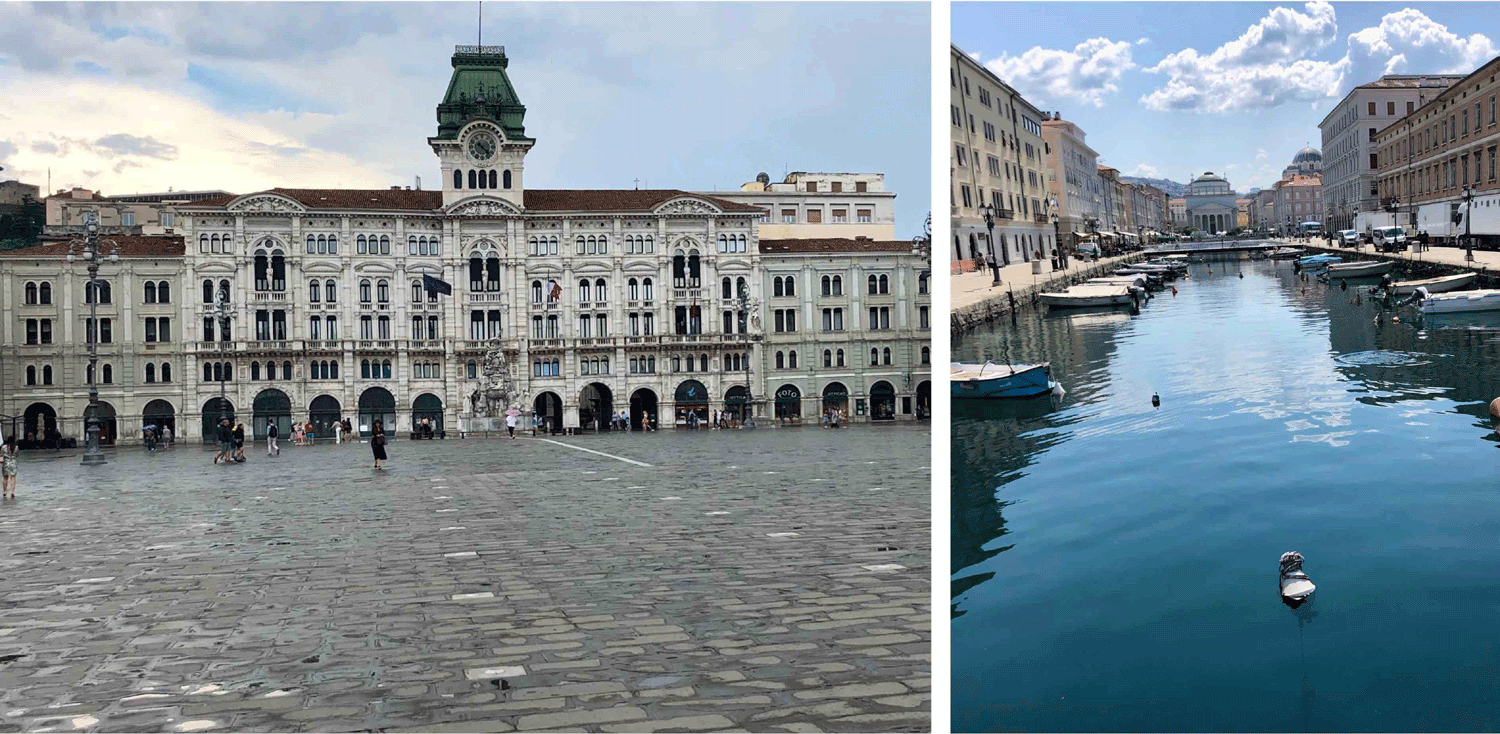
Other Trieste sites were also fascinating. The city is well known for the Canal Grande and Piazza Unitá d’Italia (the largest public square in Italy) – but in recent years Trieste has become a mecca for James Joyce fans. The author spent more than a decade there, over a sixteen year period – completing some of his most important works (e.g., Dubliners, A Portrait of the Artist as a Young Man), and developing the structure that ultimately changed Ulysses from a short story into a novel. Joyce’s path in Trieste is hard to follow, because he was always short of funds – and left a trail of disgruntled landlords in numerous apartments across the city. Today, however, he has his own museum and a statue on a bridge crossing the Canal Grande.
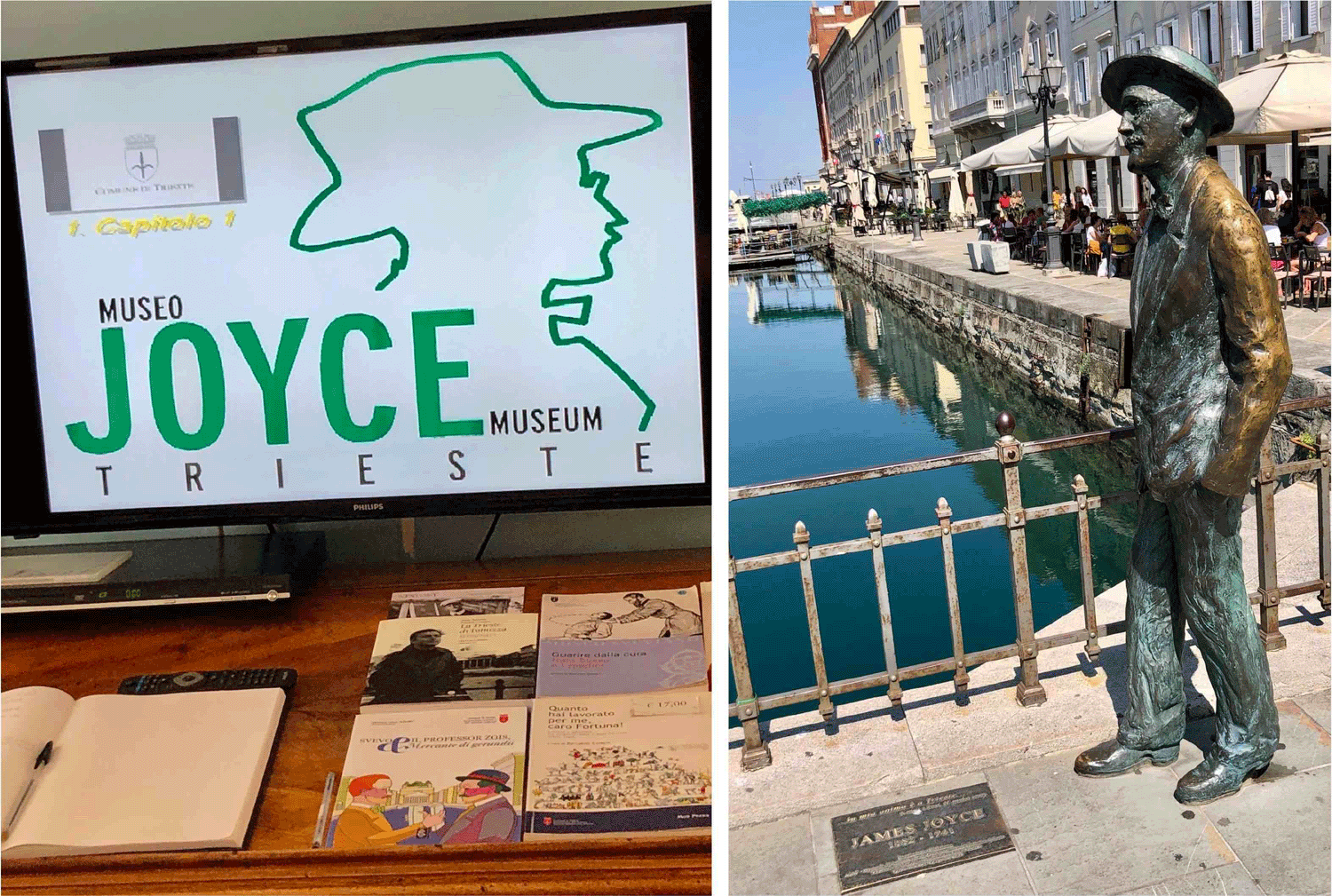
A wealthier Trieste aristocrat, Pasquale Revoltella, lived in a mansion on the Piazza Venezia near the waterfront – which today houses the Museo Revoltella and the Gallery of Modern Art. Built in the 1850’s, it’s really quite stunning – one can get a sense of the opulence in the statuary at the base of the staircase, although the picture doesn’t convey that even its banister is lined with red velvet.
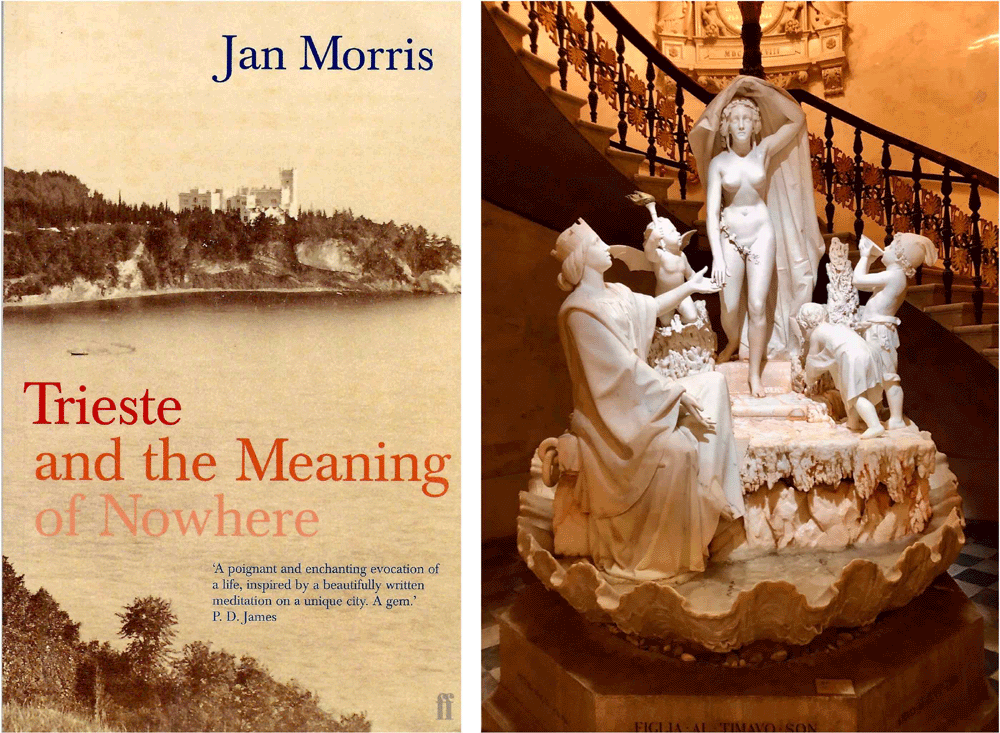
I had an early morning flight leaving Trieste, and so arranged to spend the previous night in the town of Monfalcone, closer to the airport. I hadn’t realized the importance of that town for the ship-building industry…. but that was made clear when I saw the three large cruise ships under construction on the waterfront. A ship-building museum, MuCa (Museo della Cantieristica di Monfalcone) lays out the fascinating history of that industry in the ‘company town,’ and I stayed in the Europalace Hotel – originally constructed in the 1920s as a boarding place for unmarried workers. Today it has been completely renovated, and even has its own small museum documenting a century of industrial change.
